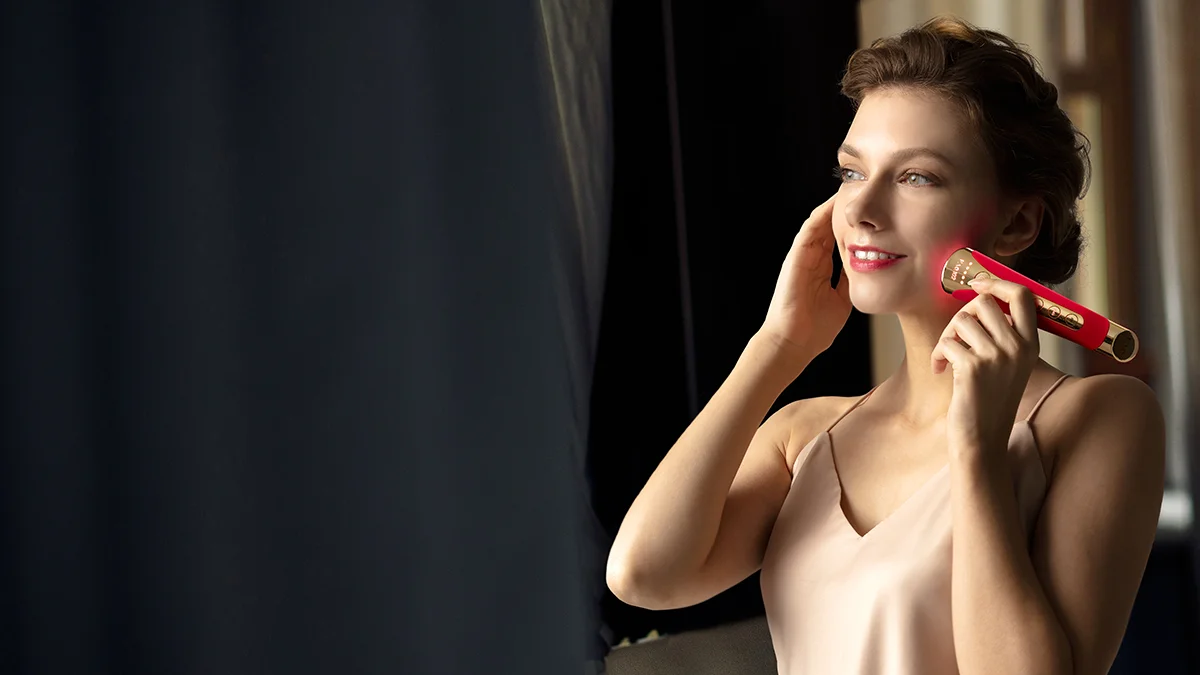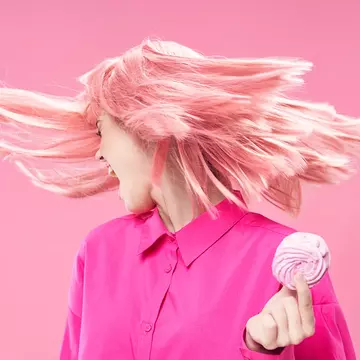7 min read
The Science Behind Red LED Light Therapy and Its Benefits

Red LED light therapy is a non-invasive treatment that has gained popularity in recent years. It involves exposing the skin to low-wavelength red light to stimulate collagen production, reduce inflammation, and increase blood circulation. The treatment is promoted as a remedy for various skin conditions and more. This article will explore the science behind red LED light therapy and its potential benefits in skin treatments and anti-aging.
How Did It All Begin?
In 1903, a Danish physician named Niels Ryberg Finsen was awarded the Nobel Prize for discovering that exposure to concentrated red light can accelerate the healing of sores. However, despite receiving the award, Finsen remained reluctant to put his discovery into practice without understanding why it worked. Fast forward to the present day, and red LED light therapy has become a popular non-invasive treatment for various skin conditions, including wrinkles, redness, acne, scars, and other signs of aging.
The treatment involves exposing the skin to low-wavelength red light to stimulate collagen production, reduce inflammation, and increase blood circulation. Researchers have also found that it can be used to treat pain, insomnia, eyesight, and even weight loss. So, while Finsen may have hesitated to put his discovery into practice over a century ago, today, red LED light therapy is a widely accepted and effective treatment for various health issues.
What Is Red Light Therapy?
Red light therapy, also commonly called photobiomodulation or low-level light therapy (LLLT), is a therapeutic treatment that may help improve acne, fine lines, wrinkles, alopecia, and other skin and health conditions. Over the years, studies have suggested that specific LED colors, particularly red and near-infrared lights, have shown promise in aiding skin healing (and are explored as a potential cancer and melanoma treatment). Here are a few studies that have explored the safety and effects of LED therapy on skin health:

Red Light (620-700 Nm)
A study published in the "Journal of Cosmetic and Laser Therapy" in 2006 demonstrated that red LED light promoted collagen production and increased fibroblast activity. This resulted in improved skin healing and reduction of wrinkles. According to an extensive study by NASA, high-intensity red and near-infrared LEDs can accelerate the healing of oxygen-deprived wounds in rats and speed up the growth and proliferation of skin, bone, and muscle cell cultures from mice and rats. Another study in the "Journal of Drugs in Dermatology" in 2014 revealed that red LED light helped improve skin complexion, texture, and tone while reducing the signs of aging.
One of the most common questions about red light therapy is whether to keep eyes open or closed. This study, published in the Journal of Physics in 2018, examined the long-term effects of low-level laser therapy (LLLT) in patients with age-related macular degeneration and showed that LLLT may be a novel long-lasting therapeutic option for an effective treatment that results in a long-term improvement of the visual acuity. This study, published in the Journal of Clinical Sleep Medicine, found that red LED light therapy can improve sleep quality and reduce insomnia symptoms.
Near-Infrared Light (700-1200 Nm)
A study in "Seminars in Cutaneous Medicine and Surgery" in 2008 highlighted the benefits of near-infrared light therapy in wound healing, skin rejuvenation, and anti-inflammatory effects.
Another research published in "Lasers in Surgery and Medicine" in 2009 reported that near-infrared LED therapy enhanced skin tissue repair and improved ulcer healing. These studies comprehensively review the existing literature on light therapy for dermatologic conditions and offer evidence-based recommendations for its use.
What Are Red Light Therapy Benefits?
Red LED light therapy has been shown to have numerous benefits for skin health, pain relief, sleep quality, and weight loss. Here are some of the benefits most often associated with red LED light:
- Skin rejuvenation: Red LED light therapy can help improve skin texture, reduce fine lines and wrinkles, and increase collagen production.
- Pain relief: Red LED light therapy has been shown to help reduce pain and inflammation in various conditions, including arthritis, carpal tunnel syndrome, and fibromyalgia.
- Improved sleep quality: Red LED light therapy can help regulate circadian rhythms and improve sleep quality, leading to better overall health.
- Weight loss: Red LED light therapy has been shown to help reduce body fat and promote faster weight loss when combined with physical activity.
These benefits make red LED light therapy a promising non-invasive treatment for various health issues.

Are There Any Negative Effects of Red Light Therapy?
While modern red light therapy has many positive benefits and is virtually free of side effects when used properly, some potential risks include mild or prolonged redness, dry, itchy skin, blistering, or hyperpigmentation. When red light therapy is used at the correct dosage (wavelength) for a particular treatment, and for an appropriate time, skin-related side effects are extremely rare.
How to Use Red Light Therapy?
Although red light therapy is considered safe, it is important to consult your healthcare provider or a board-certified dermatologist before starting the treatment. The frequency and wavelength of red light therapy treatments vary depending on the treatment area and the concern you're addressing. In addition to the professional (and mostly expensive and not covered by insurance in-office) treatments, red light therapy has also become available via at-home devices. Usually not quite as powerful, bulky, or complex to operate as the pro devices, these still provide safe and effective red light therapy benefits, are very intuitive and easy to use, and can largely be used daily if you follow the manufacturer's instructions, which we strongly recommend. It’s almost unbelievable how far technology has come in recent years. Spearheaded by new beauty-tech companies, the devices have miniaturized and become more efficient than ever, and we have access to a wide range of innovative products that can help us care for our skin from the comfort of our homes.
Best Red LED Light Devices Suggestions
One of these new impressive lines on the market that delivers salon-quality LED therapy treatments is from the new brand under the FOREO umbrella - the FAQ™ Swiss. A Swiss biotech innovator, it pushes the science of professional rejuvenation and hair treatments, locking the power into elegant hand-held devices. No clinics, no cables, no compromises for those who demand efficacy from their investments, value their time, and actively invest in self-improvement in all areas of life. Plus, they've made good use of the red LED light benefits in their portfolio. If you're interested in non-invasive at-home treatments, we'd highly recommend exploring the following FAQ™ Swiss collections:
FAQ™ 100 Collection facial wands
FAQ™ 101 - FOR THE BEGINNER: Combining Power-RF and RGB LED-Pulse (pulsing narrow beams of red, green and blue LED light) and relaxing T-Sonic™ pulsations for an overall tighter, glowing, more V-sculpted complexion.
FAQ™ 102 - FOR THE PRO: A toned, radiant, and V-sculpted complexion through a fusion of rejuvenating EMS-Pro with patented Anti-Shock System™, Power-RF, full spectrum (8 wavelengths of) LED-Pulse, and T-Sonic™ pulsations, plus professional training, and personalized treatment.
FAQ™ 103 Diamond - FOR THE SPOILED: Basically the same as FAQ™ 102, but encrusted with 5 real 0.25 Carat diamonds for those who enjoy exclusivity and those finer things in life.
Collection skincare:
FAQ™ P1 - SOMETHING SWEET: A nutrient-rich primer made with 97% natural-origin ingredients and real Manuka honey softens skin and enhances elasticity for a naturally radiant complexion, working in synergy with all of the devices' tech, but can also be used alone.

FAQ™ 200 Collection LED face masks
FAQ™ 201 - FULL REVITALIZATION: Featuring the basic red, green & blue LED, the ultra-light and wireless mask helps revitalize the complexion in minutes while you freely move around. Made of close-fitting flexi-fit silicone to ensure even light coverage and treatment quality.
FAQ™ 202 - 7 COLORS + NIR ANTI-AGING: A new generation of light-as-air, wireless LED mask that molds to all faces like a second skin with 600 optimized points of light, FAQ™ 202 features 8 different wavelengths, including NIR, to tackle signs of aging and the most common skin concerns.
FAQ™ 202 plus - MORE POWER, MORE LEDs: 50% stronger light and more LEDs, bringing the total to 634 LED light points. A "blind spot" under the forehead diamond got no LED illumination in 202. It is no longer wasted space, but an enhanced area with 9 extra LEDs focused on those very prominent angry 11s.
FAQ™ 211 - NECK & DÉCOLLETÉ REJUVENATION - A noninvasive and comfortable anti-aging solution to target sagging skin, wrinkles, and sun damage on the neck & décolleté with 8 LED colors, including NIR, and 761 optimized points of light. It can be worn reverse and treat the back of the neck, neck, and upper back.
FAQ™ 221 - ANTI-AGING HAND MASK - 623 optimized points deliver 8 different wavelengths of LED light to boost collagen and tackle aging on one of the most exposed and mistreated areas of our body - the hands.

Collection skincare:
FAQ™ Microneedling Anti-Wrinkle Hyaluronic Acid Patches for Forehead - FOR ANGRY 11s: With 100% natural origin ingredients, it works like a skin filler to reduce the look of frown lines overnight. 1,142 dissolving microneedles deliver a potent Hyaluronic Acid complex right into the skin.
FAQ™ Microneedling Anti-Wrinkle Hyaluronic Acid Patches for Under Eyes - FOR TIRED-LOOKING EYES: Reduce the look of wrinkles, dark circles & eye bags overnight. 2,270 dissolving microneedles with HA firm, plump & smooth the under-eye area.
FAQ™ Collagen Hydrogel Face Mask - FOR GLASS SKIN: Infused with a firming & smoothing Multi-Peptide Complex, soothing & repairing Edelweiss Stem Cell Extract, and plumping & elasticity-enhancing Collagen. This luxurious hydrogel mask is completely transparent, 92% natural origin, and specifically designed to be compatible with LED light treatments.
FAQ™ 300 Collection for hair thinning and hair loss
FAQ™ 301 - HAIR STRENGTHENING: Grow thicker, healthier hair with the clinical power of red LED light and T-Sonic™ massage that combats male and female hair thinning by improving hair and scalp health overall. Reduce hair loss by up to 41% and increase hair glossiness by 40% in just 1 month.
FAQ™ 302 - LASER & LED HAIR REGROWTH: Clinical laser therapy & red LED light help regrow your hairline, temples & crown by reactivating dormant hair follicles. Combined with T-Sonic™ massage to dislodge buildup and stimulate blood flow, you'll see noticeably thicker and longer strands and Increase hair growth & density by up to 47%.

Collection haircare:
FAQ™ Scalp Recovery & Thick Hair Probiotic Serum - BOOST THICKER HAIR: A lightweight leave-in serum formulated with microbiome-balancing Probiotics that help combat flakiness or oily scalp, hair-strengthening & volumizing Red Clover Extract, and follicle-repairing & protecting Centella Asiatica.









Comments
11 comments
Leave a comment